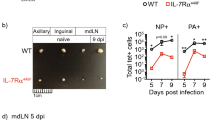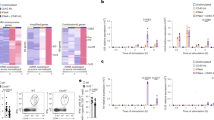Abstract
Interleukin (IL)-10 is an important regulatory cytokine that can modulate excessive immune mediated injury. Several distinct cell types have been demonstrated to produce IL-10, including most recently CD8+ cytotoxic T lymphocytes (CTLs) responding to respiratory virus infection. Here we report that CD4+ T cell help in the form of IL-2 is required for IL-10 production by CTLs, but not for the induction of CTL effector cytokines. We show that IL-2 derived from CD4+ helper T cells cooperates with innate immune cell–derived IL-27 to amplify IL-10 production by CTLs through a Blimp-1-dependent mechanism. These findings reveal a previously unrecognized pathway that coordinates signals derived from innate and helper T cells to control the production of a regulatory cytokine by CTLs during acute viral infection.
This is a preview of subscription content, access via your institution
Access options
Subscribe to this journal
Receive 12 print issues and online access
$209.00 per year
only $17.42 per issue
Buy this article
- Purchase on Springer Link
- Instant access to full article PDF
Prices may be subject to local taxes which are calculated during checkout







Similar content being viewed by others
References
Moore, K.W., de Waal Malefyt, R., Coffman, R.L. & O'Garra, A. Interleukin-10 and the interleukin-10 receptor. Annu. Rev. Immunol. 19, 683–765 (2001).
Couper, K.N., Blount, D.G. & Riley, E.M. IL-10: the master regulator of immunity to infection. J. Immunol. 180, 5771–5777 (2008).
Saraiva, M. & O'Garra, A. The regulation of IL-10 production by immune cells. Nat. Rev. Immunol. 10, 170–181 (2010).
Anderson, C.F., Oukka, M., Kuchroo, V.J. & Sacks, D. CD4+CD25-Foxp3- Th1 cells are the source of IL-10-mediated immune suppression in chronic cutaneous leishmaniasis. J. Exp. Med. 204, 285–297 (2007).
Jankovic, D. et al. Conventional T-bet+Foxp3- Th1 cells are the major source of host-protective regulatory IL-10 during intracellular protozoan infection. J. Exp. Med. 204, 273–283 (2007).
Sun, J., Madan, R., Karp, C.L. & Braciale, T.J. Effector T cells control lung inflammation during acute influenza virus infection by producing IL-10. Nat. Med. 15, 277–284 (2009).
O'Garra, A. & Vieira, P. TH1 cells control themselves by producing interleukin-10. Nat. Rev. Immunol. 7, 425–428 (2007).
Barrat, F.J. et al. In vitro generation of interleukin 10-producing regulatory CD4+ T cells is induced by immunosuppressive drugs and inhibited by T helper type 1 (Th1)- and Th2-inducing cytokines. J. Exp. Med. 195, 603–616 (2002).
Maynard, C.L. et al. Regulatory T cells expressing interleukin 10 develop from Foxp3+ and Foxp3− precursor cells in the absence of interleukin 10. Nat. Immunol. 8, 931–941 (2007).
Pot, C. et al. Cutting edge: IL-27 induces the transcription factor c-Maf, cytokine IL-21, and the costimulatory receptor ICOS that coordinately act together to promote differentiation of IL-10-producing Tr1 cells. J. Immunol. 183, 797–801 (2009).
Apetoh, L. et al. The aryl hydrocarbon receptor interacts with c-Maf to promote the differentiation of type 1 regulatory T cells induced by IL-27. Nat. Immunol. 11, 854–861 (2010).
Gandhi, R. et al. Activation of the aryl hydrocarbon receptor induces human type 1 regulatory T cell-like and Foxp3+ regulatory T cells. Nat. Immunol. 11, 846–853 (2010).
Fitzgerald, D.C. et al. Suppression of autoimmune inflammation of the central nervous system by interleukin 10 secreted by interleukin 27-stimulated T cells. Nat. Immunol. 8, 1372–1379 (2007).
Stumhofer, J.S. et al. Interleukins 27 and 6 induce STAT3-mediated T cell production of interleukin 10. Nat. Immunol. 8, 1363–1371 (2007).
Jankovic, D. & Trinchieri, G. IL-10 or not IL-10: that is the question. Nat. Immunol. 8, 1281–1283 (2007).
Spolski, R., Kim, H.P., Zhu, W., Levy, D.E. & Leonard, W.J. IL-21 mediates suppressive effects via its induction of IL-10. J. Immunol. 182, 2859–2867 (2009).
Saraiva, M. et al. Interleukin-10 production by Th1 cells requires interleukin-12-induced STAT4 transcription factor and ERK MAP kinase activation by high antigen dose. Immunity 31, 209–219 (2009).
Collison, L.W. et al. The inhibitory cytokine IL-35 contributes to regulatory T-cell function. Nature 450, 566–569 (2007).
Belz, G.T., Wodarz, D., Diaz, G., Nowak, M.A. & Doherty, P.C. Compromised influenza virus-specific CD8(+)-T-cell memory in CD4+-T-cell-deficient mice. J. Virol. 76, 12388–12393 (2002).
Johnson, S. et al. Selected Toll-like receptor ligands and viruses promote helper-independent cytotoxic T cell priming by upregulating CD40L on dendritic cells. Immunity 30, 218–227 (2009).
Madan, R. et al. Nonredundant roles for B cell-derived IL-10 in immune counter-regulation. J. Immunol. 183, 2312–2320 (2009).
Stetson, D.B. et al. Constitutive cytokine mRNAs mark natural killer (NK) and NK T cells poised for rapid effector function. J. Exp. Med. 198, 1069–1076 (2003).
Malek, T.R. The biology of interleukin-2. Annu. Rev. Immunol. 26, 453–479 (2008).
Belz, G.T. & Masson, F. Interleukin-2 tickles T cell memory. Immunity 32, 7–9 (2010).
Gong, D. & Malek, T.R. Cytokine-dependent Blimp-1 expression in activated T cells inhibits IL-2 production. J. Immunol. 178, 242–252 (2007).
Martins, G.A. et al. Transcriptional repressor Blimp-1 regulates T cell homeostasis and function. Nat. Immunol. 7, 457–465 (2006).
Sun, J.C., Williams, M.A. & Bevan, M.J. CD4+ T cells are required for the maintenance, not programming, of memory CD8+ T cells after acute infection. Nat. Immunol. 5, 927–933 (2004).
Sun, J.C. & Bevan, M.J. Defective CD8 T cell memory following acute infection without CD4 T cell help. Science 300, 339–342 (2003).
Shedlock, D.J. & Shen, H. Requirement for CD4 T cell help in generating functional CD8 T cell memory. Science 300, 337–339 (2003).
Nakanishi, Y., Lu, B., Gerard, C. & Iwasaki, A. CD8+ T lymphocyte mobilization to virus-infected tissue requires CD4+ T-cell help. Nature 462, 510–513 (2009).
Keene, J.A. & Forman, J. Helper activity is required for the in vivo generation of cytotoxic T lymphocytes. J. Exp. Med. 155, 768–782 (1982).
Bennett, S.R., Carbone, F.R., Karamalis, F., Miller, J.F. & Heath, W.R. Induction of a CD8+ cytotoxic T lymphocyte response by cross-priming requires cognate CD4+ T cell help. J. Exp. Med. 186, 65–70 (1997).
Zhang, S., Zhang, H. & Zhao, J. The role of CD4 T cell help for CD8 CTL activation. Biochem. Biophys. Res. Commun. 384, 405–408 (2009).
Pipkin, M.E. et al. Interleukin-2 and inflammation induce distinct transcriptional programs that promote the differentiation of effector cytolytic T cells. Immunity 32, 79–90 (2010).
Kalia, V. et al. Prolonged interleukin-2Rα expression on virus-specific CD8+ T cells favors terminal-effector differentiation in vivo. Immunity 32, 91–103 (2010).
Kohlmeier, J.E., Cookenham, T., Roberts, A.D., Miller, S.C. & Woodland, D.L. Type I interferons regulate cytolytic activity of memory CD8+ T cells in the lung airways during respiratory virus challenge. Immunity 33, 96–105 (2010).
Stumhofer, J.S. & Hunter, C.A. Advances in understanding the anti-inflammatory properties of IL-27. Immunol. Lett. 117, 123–130 (2008).
Yoshida, H., Nakaya, M. & Miyazaki, Y. Interleukin 27: a double-edged sword for offense and defense. J. Leukoc. Biol. 86, 1295–1303 (2009).
Crotty, S., Johnston, R.J. & Schoenberger, S.P. Effectors and memories: Bcl-6 and Blimp-1 in T and B lymphocyte differentiation. Nat. Immunol. 11, 114–120 (2010).
Kallies, A., Xin, A., Belz, G.T. & Nutt, S.L. Blimp-1 transcription factor is required for the differentiation of effector CD8+ T cells and memory responses. Immunity 31, 283–295 (2009).
Shin, H. et al. A role for the transcriptional repressor Blimp-1 in CD8+ T cell exhaustion during chronic viral infection. Immunity 31, 309–320 (2009).
Lawrence, C.W. & Braciale, T.J. Activation, differentiation, and migration of naive virus-specific CD8+ T cells during pulmonary influenza virus infection. J. Immunol. 173, 1209–1218 (2004).
Acknowledgements
We thank the rest of Braciale laboratory for critical comments and B. Small for excellent technical assistance. We thank C.L. Karp (Cincinnati Children's Hospital Medical Center), M. Mohrs (Trudeau Institute), W. Leonard (US National Institutes of Health) and T.R. Malek (University of Miami) for reagents. This work was supported by the US National Institutes of Health (grants AI-15608, HL-33391, AI-37293 and U19 AI-083024 to T.J.B.), University of Virginia Center for Immunity, Inflammation and Regenerative Medicine start-up funds to R.S. and an American Lung Association Postdoctoral Fellowship (RN-123000) to J.S.
Author information
Authors and Affiliations
Contributions
J.S. designed the project, performed most of the experimental work, analyzed the data and wrote the manuscript. H.D. and E.K.M. performed some of the quantitative RT-PCR and ELISA experiments. R.S. contributed to reagents and suggestions. T.J.B. supervised the project, analyzed the data and wrote the manuscript.
Corresponding author
Ethics declarations
Competing interests
The authors declare no competing financial interests.
Supplementary information
Supplementary Text and Figures
Supplementary Figures 1–22 (PDF 2015 kb)
Rights and permissions
About this article
Cite this article
Sun, J., Dodd, H., Moser, E. et al. CD4+ T cell help and innate-derived IL-27 induce Blimp-1-dependent IL-10 production by antiviral CTLs. Nat Immunol 12, 327–334 (2011). https://doi.org/10.1038/ni.1996
Received:
Accepted:
Published:
Issue Date:
DOI: https://doi.org/10.1038/ni.1996
This article is cited by
-
The effect of BKV reactivation on cytokines behavior in kidney transplanted patients
BMC Nephrology (2022)
-
In vitro anti-influenza assessment of anionic compounds ascorbate, acetate and citrate
Virology Journal (2022)
-
A polymeric co-assembly of subunit vaccine with polyoxometalates induces enhanced immune responses
Nano Research (2022)
-
Genetic influences on viral-induced cytokine responses in the lung
Mucosal Immunology (2021)
-
Regulatory cytokine function in the respiratory tract
Mucosal Immunology (2019)



